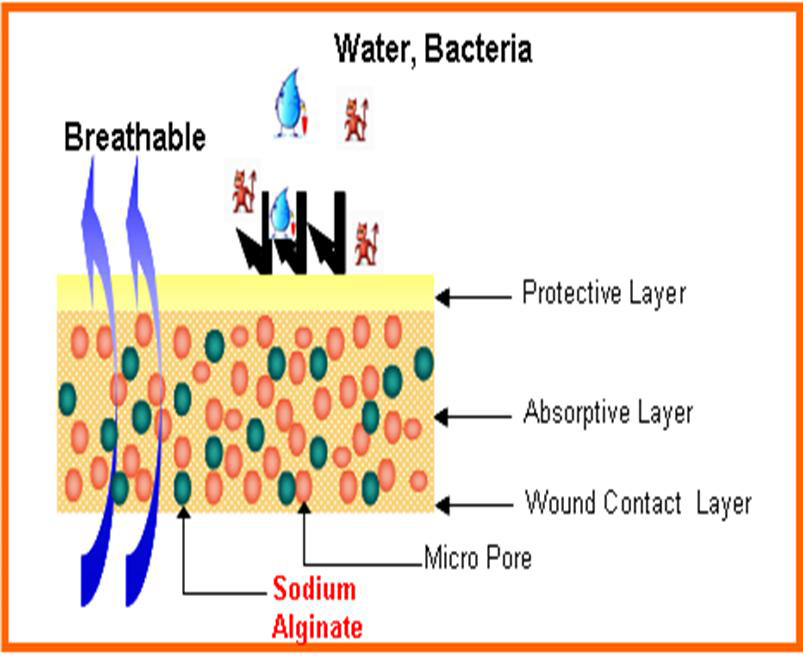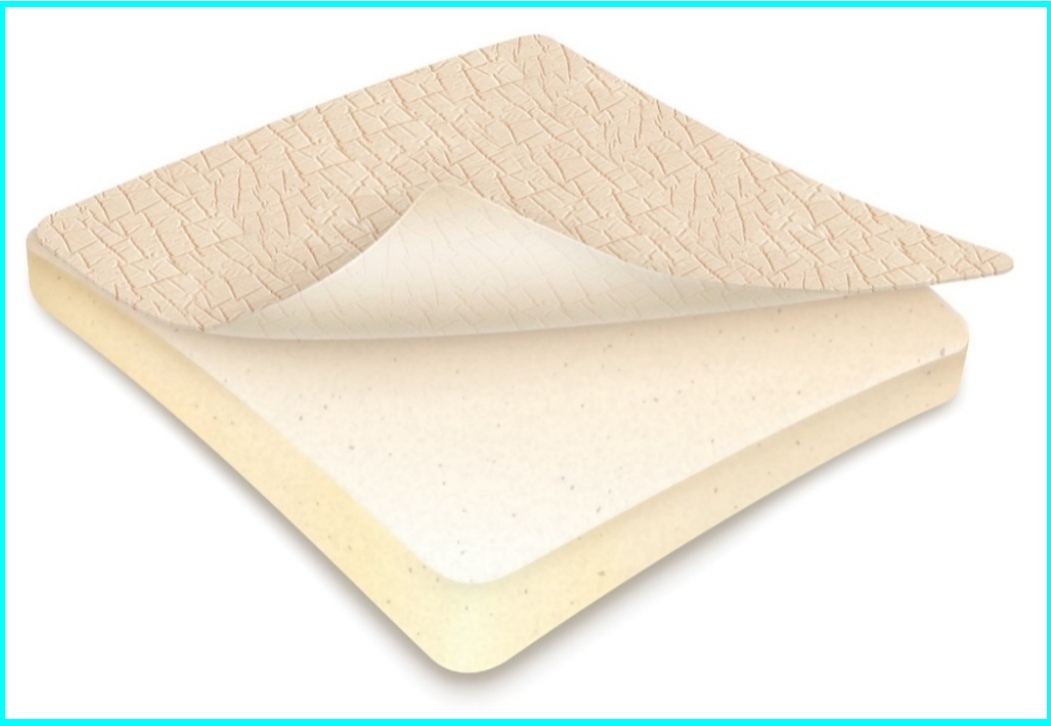Products Details
 ●Highly breathable film protective layer allows water vapor permeation while avoiding microorganism contamination. ●Double fluid absorption: excellent exudate absorption and gel formation of alginate. ●Moist wound environment promotes granulation and epithelialization. ●Pore size is small enough that granulation tissue can’t not grow into it. ●Gelation after alginate absorption and protect nerve endings ●The calcium content exerts hemostasis function
●Highly breathable film protective layer allows water vapor permeation while avoiding microorganism contamination. ●Double fluid absorption: excellent exudate absorption and gel formation of alginate. ●Moist wound environment promotes granulation and epithelialization. ●Pore size is small enough that granulation tissue can’t not grow into it. ●Gelation after alginate absorption and protect nerve endings ●The calcium content exerts hemostasis function ●Moist foam with comfortable touch, helping maintain micro-environment for wound healing. ●Super small micro pores on wound contacting layer with gelling nature when contacting fluid to facilitate atraumatic removal. ●Contains sodium alginate for enhanced fluid retention and hemostatic property. ●Excellent wound exudate handling capability thanks to both good liquid absorption and water vapor permeability. N type has a clear and identifiable protective layer, and it is easy to observe the absorption of exudate in the absorption layer. Glycerin:Soft, Strong plasticity,Excellent adhesion,Good adaptability Absorption Layer:Vertical absorption capacity ensures optimal fluid balance to support moist wound healing. Protective Layer:Waterproof,Breathability,Resistance to bacteria Wound Contact layer:< 20 micron pores can prevent tissue growing inside.Protect wound Provide moist wound environment Pressure ulcers prevention ●Acute wound(incision site、 Shallow Ⅱ degree burns 、 skin graft site、donor site) ●Chronic exudative wounds(pressure ulcers、diabetic foot ulcers)
●Moist foam with comfortable touch, helping maintain micro-environment for wound healing. ●Super small micro pores on wound contacting layer with gelling nature when contacting fluid to facilitate atraumatic removal. ●Contains sodium alginate for enhanced fluid retention and hemostatic property. ●Excellent wound exudate handling capability thanks to both good liquid absorption and water vapor permeability. N type has a clear and identifiable protective layer, and it is easy to observe the absorption of exudate in the absorption layer. Glycerin:Soft, Strong plasticity,Excellent adhesion,Good adaptability Absorption Layer:Vertical absorption capacity ensures optimal fluid balance to support moist wound healing. Protective Layer:Waterproof,Breathability,Resistance to bacteria Wound Contact layer:< 20 micron pores can prevent tissue growing inside.Protect wound Provide moist wound environment Pressure ulcers prevention ●Acute wound(incision site、 Shallow Ⅱ degree burns 、 skin graft site、donor site) ●Chronic exudative wounds(pressure ulcers、diabetic foot ulcers) N type for donor site Clinical Case: Donor Site Patient: Female, 45 years old, donor site on right leg, bleeding and painful, moderate exudate. Treatment: 1. Clean the wound and the surrounding skin. 2. Use N type foam in accordance with the size of wound. Secure it with a bandage. 3. Exudate was absorbed. The alginate in the foam helped to reduce the bleeding and the gel protected the wound and reduced the pain. 4. The foam dressing was used for 2-3 days until the replacement. N type for chemical burns Clinical Case: Chemical burns Patient: Male, 46 years old, 36 hours after chemical burns Treatment: 1.Clean the wound 2.Remove collapsed blisters and fluid(picture2). 3.Use N type foam to absorb the severe exudate and maintain the moist environment for wound (picture3). 4. The granulation tissue on the wound grew well and smooth after 2 days(picture4) 5. The exudate decreased after 5 days(picture5). 6. Use Hydrocolloid dressing to promote epithelial crawling and accelerate wound healing(picture6) Recommendation of common N Type Foam Dressing in clinical departments ●Burn department: -Burn and scald: N Type 20*20、 35*50 -Donor site,skin graft area and skin flap transplantation: N Type 10*10、 20*20 ●Department of orthopedics: -Surgical incision of infection nonunion: In the case of sever infection, it is recommended to recommend the Type N with the boundless foam. ●General surgery(including hepatobiliary surgery,vascular surgery,breast surgery) urology: -Surgical incision of infection nonunion: In the case of sever infection, it is recommended to recommend the Type N with the boundless foam.
N type for donor site Clinical Case: Donor Site Patient: Female, 45 years old, donor site on right leg, bleeding and painful, moderate exudate. Treatment: 1. Clean the wound and the surrounding skin. 2. Use N type foam in accordance with the size of wound. Secure it with a bandage. 3. Exudate was absorbed. The alginate in the foam helped to reduce the bleeding and the gel protected the wound and reduced the pain. 4. The foam dressing was used for 2-3 days until the replacement. N type for chemical burns Clinical Case: Chemical burns Patient: Male, 46 years old, 36 hours after chemical burns Treatment: 1.Clean the wound 2.Remove collapsed blisters and fluid(picture2). 3.Use N type foam to absorb the severe exudate and maintain the moist environment for wound (picture3). 4. The granulation tissue on the wound grew well and smooth after 2 days(picture4) 5. The exudate decreased after 5 days(picture5). 6. Use Hydrocolloid dressing to promote epithelial crawling and accelerate wound healing(picture6) Recommendation of common N Type Foam Dressing in clinical departments ●Burn department: -Burn and scald: N Type 20*20、 35*50 -Donor site,skin graft area and skin flap transplantation: N Type 10*10、 20*20 ●Department of orthopedics: -Surgical incision of infection nonunion: In the case of sever infection, it is recommended to recommend the Type N with the boundless foam. ●General surgery(including hepatobiliary surgery,vascular surgery,breast surgery) urology: -Surgical incision of infection nonunion: In the case of sever infection, it is recommended to recommend the Type N with the boundless foam.
Monochrome Aesthetic,
Monosyn,
Stratafix Vs Vloc,
Veterinary Specialty Hospital,
Plaster To Cover Wound,
Opsite Post Op,
The Veterinary Hospital,
Polytetrafluoroethylene Sheet,
Dermaview Transparent Film Dressing,
Veterinary Medical Center,
 ●Highly breathable film protective layer allows water vapor permeation while avoiding microorganism contamination. ●Double fluid absorption: excellent exudate absorption and gel formation of alginate. ●Moist wound environment promotes granulation and epithelialization. ●Pore size is small enough that granulation tissue can’t not grow into it. ●Gelation after alginate absorption and protect nerve endings ●The calcium content exerts hemostasis function
●Highly breathable film protective layer allows water vapor permeation while avoiding microorganism contamination. ●Double fluid absorption: excellent exudate absorption and gel formation of alginate. ●Moist wound environment promotes granulation and epithelialization. ●Pore size is small enough that granulation tissue can’t not grow into it. ●Gelation after alginate absorption and protect nerve endings ●The calcium content exerts hemostasis function ●Moist foam with comfortable touch, helping maintain micro-environment for wound healing. ●Super small micro pores on wound contacting layer with gelling nature when contacting fluid to facilitate atraumatic removal. ●Contains sodium alginate for enhanced fluid retention and hemostatic property. ●Excellent wound exudate handling capability thanks to both good liquid absorption and water vapor permeability. N type has a clear and identifiable protective layer, and it is easy to observe the absorption of exudate in the absorption layer. Glycerin:Soft, Strong plasticity,Excellent adhesion,Good adaptability Absorption Layer:Vertical absorption capacity ensures optimal fluid balance to support moist wound healing. Protective Layer:Waterproof,Breathability,Resistance to bacteria Wound Contact layer:< 20 micron pores can prevent tissue growing inside.Protect wound Provide moist wound environment Pressure ulcers prevention ●Acute wound(incision site、 Shallow Ⅱ degree burns 、 skin graft site、donor site) ●Chronic exudative wounds(pressure ulcers、diabetic foot ulcers)
●Moist foam with comfortable touch, helping maintain micro-environment for wound healing. ●Super small micro pores on wound contacting layer with gelling nature when contacting fluid to facilitate atraumatic removal. ●Contains sodium alginate for enhanced fluid retention and hemostatic property. ●Excellent wound exudate handling capability thanks to both good liquid absorption and water vapor permeability. N type has a clear and identifiable protective layer, and it is easy to observe the absorption of exudate in the absorption layer. Glycerin:Soft, Strong plasticity,Excellent adhesion,Good adaptability Absorption Layer:Vertical absorption capacity ensures optimal fluid balance to support moist wound healing. Protective Layer:Waterproof,Breathability,Resistance to bacteria Wound Contact layer:< 20 micron pores can prevent tissue growing inside.Protect wound Provide moist wound environment Pressure ulcers prevention ●Acute wound(incision site、 Shallow Ⅱ degree burns 、 skin graft site、donor site) ●Chronic exudative wounds(pressure ulcers、diabetic foot ulcers) N type for donor site Clinical Case: Donor Site Patient: Female, 45 years old, donor site on right leg, bleeding and painful, moderate exudate. Treatment: 1. Clean the wound and the surrounding skin. 2. Use N type foam in accordance with the size of wound. Secure it with a bandage. 3. Exudate was absorbed. The alginate in the foam helped to reduce the bleeding and the gel protected the wound and reduced the pain. 4. The foam dressing was used for 2-3 days until the replacement. N type for chemical burns Clinical Case: Chemical burns Patient: Male, 46 years old, 36 hours after chemical burns Treatment: 1.Clean the wound 2.Remove collapsed blisters and fluid(picture2). 3.Use N type foam to absorb the severe exudate and maintain the moist environment for wound (picture3). 4. The granulation tissue on the wound grew well and smooth after 2 days(picture4) 5. The exudate decreased after 5 days(picture5). 6. Use Hydrocolloid dressing to promote epithelial crawling and accelerate wound healing(picture6) Recommendation of common N Type Foam Dressing in clinical departments ●Burn department: -Burn and scald: N Type 20*20、 35*50 -Donor site,skin graft area and skin flap transplantation: N Type 10*10、 20*20 ●Department of orthopedics: -Surgical incision of infection nonunion: In the case of sever infection, it is recommended to recommend the Type N with the boundless foam. ●General surgery(including hepatobiliary surgery,vascular surgery,breast surgery) urology: -Surgical incision of infection nonunion: In the case of sever infection, it is recommended to recommend the Type N with the boundless foam.
N type for donor site Clinical Case: Donor Site Patient: Female, 45 years old, donor site on right leg, bleeding and painful, moderate exudate. Treatment: 1. Clean the wound and the surrounding skin. 2. Use N type foam in accordance with the size of wound. Secure it with a bandage. 3. Exudate was absorbed. The alginate in the foam helped to reduce the bleeding and the gel protected the wound and reduced the pain. 4. The foam dressing was used for 2-3 days until the replacement. N type for chemical burns Clinical Case: Chemical burns Patient: Male, 46 years old, 36 hours after chemical burns Treatment: 1.Clean the wound 2.Remove collapsed blisters and fluid(picture2). 3.Use N type foam to absorb the severe exudate and maintain the moist environment for wound (picture3). 4. The granulation tissue on the wound grew well and smooth after 2 days(picture4) 5. The exudate decreased after 5 days(picture5). 6. Use Hydrocolloid dressing to promote epithelial crawling and accelerate wound healing(picture6) Recommendation of common N Type Foam Dressing in clinical departments ●Burn department: -Burn and scald: N Type 20*20、 35*50 -Donor site,skin graft area and skin flap transplantation: N Type 10*10、 20*20 ●Department of orthopedics: -Surgical incision of infection nonunion: In the case of sever infection, it is recommended to recommend the Type N with the boundless foam. ●General surgery(including hepatobiliary surgery,vascular surgery,breast surgery) urology: -Surgical incision of infection nonunion: In the case of sever infection, it is recommended to recommend the Type N with the boundless foam.